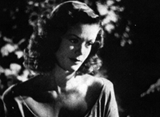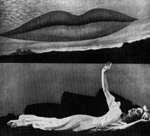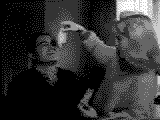The "curse", which haunts the story, assumes a number of dimensions: it is the oath uttered by the mother who disowns her offspring; the curse of the imagination which threatens to overwhelm Amy; and the curse which hangs over the house in the form of Irena, the cat-woman, who is also a man-killer. Although Irene appears an almost magical, benevolent figure, she comes--as she tells Amy--from a place of "great darkness and deep peace".
When Amy says to Irena, "I shall wait for you for always", she points to her own morbid attraction to death, her desire to exit a world, ruled by the mundane, and filled with little cruelties. Amy's mother verbalises her fears when she tells Amy's teacher about Irena: "its almost as if there's a curse on us It's on Amy. I sometimes think there is a curse on this house". The Cat People's "curse" which afflicts Amy is inherited psychically from her father's dead first wife, Irena. The narrative not only emphasises that Irena is Amy's "real" mother, it presents them in a close relationship--physically and emotionally. Irena is her "special friend." Together they retreat into a world of fantasy, symbolised by the garden and by its extension--the forest in which dwells the Headless Horseman.
Possibly, the most significant meaning of the "curse" concerns the curse of the headless horseman. Like Orpheus, Osiris, John the Baptist and Holofernes, the headless horseman belongs to a bloody tradition in which men are destroyed/decapitated by women. Freud (1922) refers to decapitation as a symbolic representation of castration--perhaps this is what Irena represents, the castrating cat/woman who rips open the male body with her sharp claws and fangs. Irena herself believes she is cursed and must kill the men she loves. It is not by accident that Irena's ghost dwells in Sleepy Hollow, place of dream/nightmares and home of the ghostly headless male, and that Amy's house is located on its outskirts. The curse of female desire is passed from a symbolic, if not real, "mother" to daughter, from Irena to Amy.
The ambiguous final scene, in which the father claims also to "see" Irena, could mean that he, at last, will enter imaginatively into Amy's world of play, or that both father and daughter will forsake the living and be drawn irrevocably into Irena's dark realm. However, the father cannot enter alone--he needs his daughter, and her mystical powers, to guide him through to the other side. The film's great strength presides in its ambiguities, beautifully realised by an expressive use of shadows, light and shade, and poetic compositions.
The view of the female child as particularly close to the non-material world of fantasy and the imagination was central to the beliefs of the Surrealists. They regarded childhood as "the privileged age in which imaginative faculties were still 'a l'etat sauvage--sensitive to all kinds of impressions and associations which education would systematically 'correct" (Webb and Short, 42). "Dissecting mystery is like violating a child," Bunuel was fond of saying. (1994, 92). In the 1924 Manifesto, Breton claimed: 'The spirit which takes the plunge into Surrealism exultantly relives the best of its childhood." (Webb and Short, 47)
They endowed the female child, whom they idealised as the "femme-enfant," with a special ability to enter the realm of the marvellous. Through her, the surrealists hoped to return to a state of lost innocence and capture again that special state of childhood wonderment at the mysteries and magic of life. A famous Man Ray photograph shows a group of his colleagues listening in rapt attention to the young Gisele Prassinos reading her poetry which, to them, was truly marvellous. For the surrealists the crucial aspect of the femme-enfant, is her innocence. By virtue of her purity, she is able to make contact with the marvellous and enter the world of the surreal. Films like Curse of the Cat People and The Innocents explore the dark side of this experience. More recent films, such as Poltergeist, take us--via special effects technology--right inside the surreal nightmarish world of the femme-enfant. The surrealists, however, did not depict the femme-enfant only as an angel. Salvadore Dali endowed her with a dark side. When Dali painted Shirley Temple, Hollywood's quintessential image of childhood innocence, he gave her a sphinx's body, coloured red, and sporting long dangerous claws. Hans Belmer's dolls--twisted into seductive poses of the nymphet--also point to the girl's potential for corruption. Lolita the deadly woman/child, was terrifying because her innocent demeanour concealed--what the audience knew--that she was already corrupt. Passivity invites attention and innocence invites corruption--the more pure and irreproachable, the greater will be the child's fall from grace. Still not fully developed or formed, the girl child is malleable, capable of representing destructive archaic impulses as well innocence and the potential for good.


